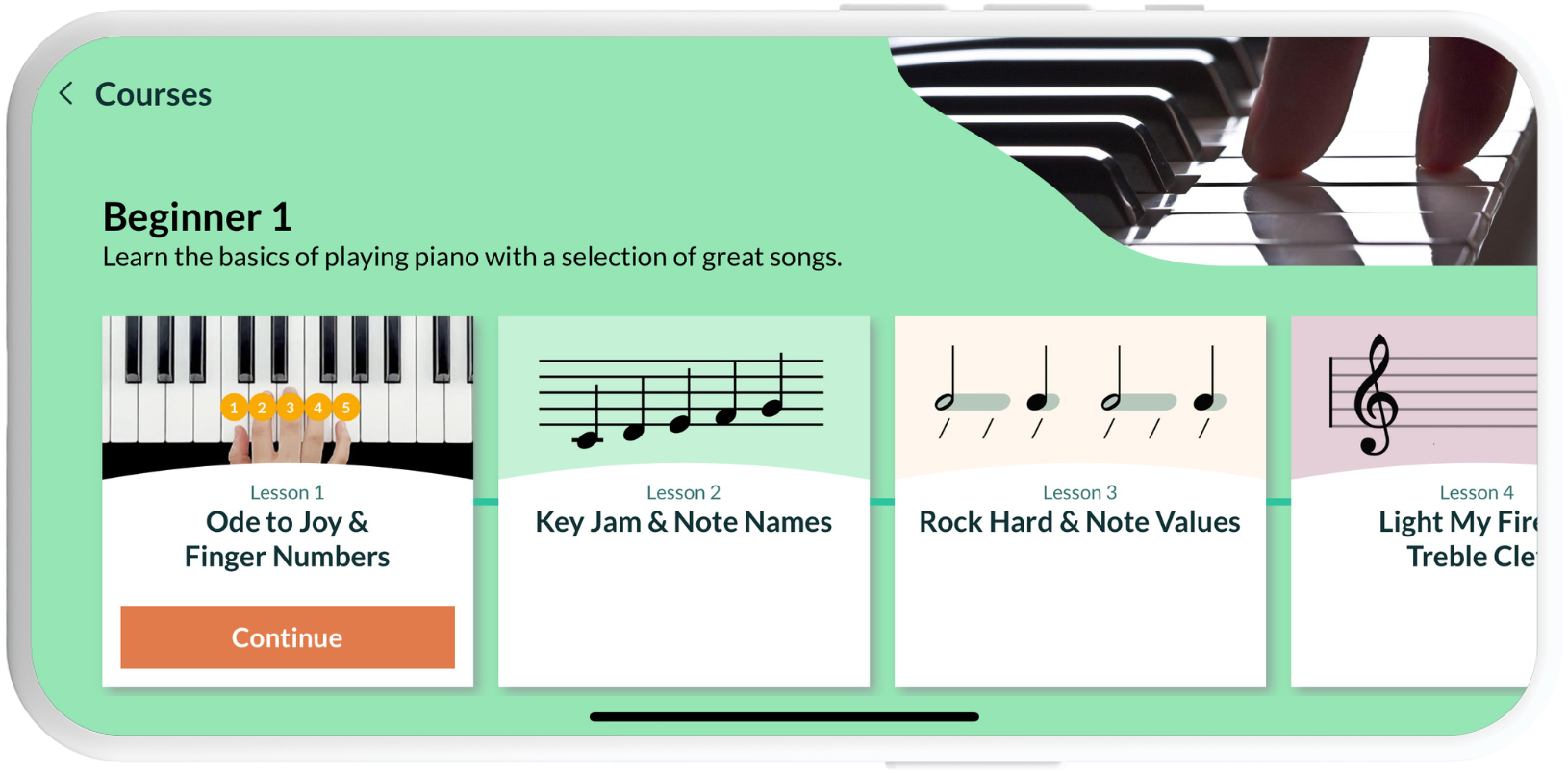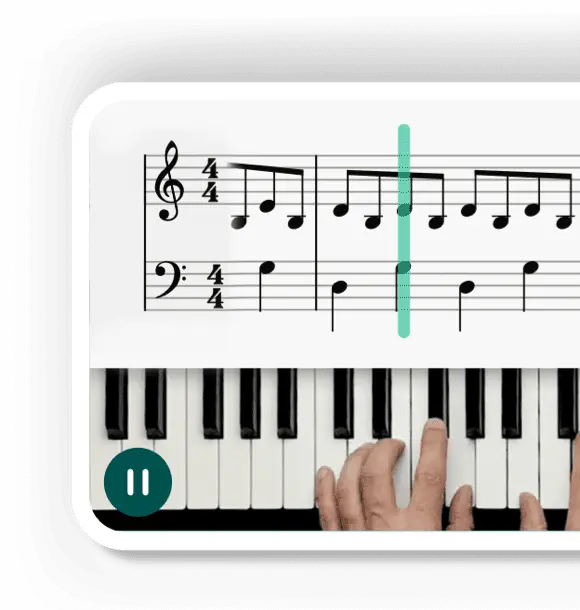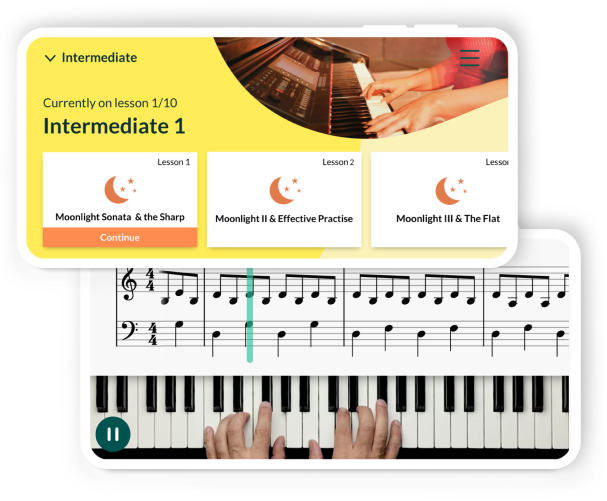Scales are like the building blocks of music. They’re a sequence of notes that provide a foundation for melodies and harmonies. Think of them as the “ABCs” of music. You wouldn’t write a novel without knowing your alphabet, right? The same goes for composing a tune; you need to know your scales. Today we are going to explore the fascinating world of piano pentatonic scales.
Now, let’s sprinkle a little more magic dust on pentatonic scales. These scales are the ultimate go-to for many genres, from blues and jazz to rock and pop. Why? Because they’re incredibly versatile and forgiving. With just five notes, pentatonic scales eliminate the risk of hitting a “wrong” note, making them perfect for beginners. So, if you’re looking to switch off from the daily grind and experience something new, pentatonic scales are your gateway to musical freedom.
And hey, if you’re searching for a self-learning tool to master these scales, Skoove has got your back. It’s like having a personal piano teacher in your pocket.

No credit card details required
What is a pentatonic scale?
A pentatonic scale is a piano scale with just five notes per octave. Yep, you heard that right—only five! While other scales might have you juggling seven or more notes, the pentatonic scale keeps it simple. It’s like the minimalist of the music world, and it’s perfect for those who are new to the piano.
The formula of a major pentatonic scale
Ready for some music math? Don’t worry; it’s easier than it sounds. The major pentatonic scale formula is a sequence of whole and half steps between the notes. Here’s how it goes:
- Whole Step
- Whole Step
- Minor Third (1.5 steps)
- Whole Step
- Minor Third (1.5 steps)
For example, let’s take the C major pentatonic scale on piano. The notes would be C, D, E, G, and A. Notice how we skipped F and B? That’s the beauty of the pentatonic scale; it eliminates the notes that often cause dissonance.
The formula of a minor pentatonic scale
Now, let’s flip the script and talk about the minor pentatonic scale on piano. This one’s got a different vibe but the same simplicity. Here’s the formula:
- Minor Third (1.5 steps)
- Whole Step
- Whole Step
- Minor Third (1.5 steps)
- Whole Step
For instance, the A minor pentatonic scale would consist of the notes A, C, D, E, and G. It’s got a more soulful, bluesy feel compared to its major counterpart.
Popular pentatonic scales on piano
Okay, let’s put it all together. Whether you’re into major pentatonic scale piano melodies or you’re vibing with minor pentatonic scale piano tunes, here’s a quick rundown of some popular pentatonic scales on the piano:
Major pentatonic scales:
- C major pentatonic: C, D, E, G, A
- D major pentatonic: D, E, F♯, A, B
- E major pentatonic: E, F♯, G♯, B, C♯
- G major pentatonic: G, A, B, D, E
- A major pentatonic: A, B, C♯, E, F♯
Minor pentatonic scales:
- A minor pentatonic: A, C, D, E, G
- C minor pentatonic: C, E♭, F, G, B♭
- D minor pentatonic: D, F, G, A, C
- E minor pentatonic: E, G, A, B, D
- G minor pentatonic: G, B♭, C, D, F
The science of the pentatonic scale
This scale works so well because it’s based on the natural harmonic series. In layman’s terms, it resonates with the fundamental physics of sound. It’s like the universe gave us a cheat code for making music that feels good!
Remember those notes we skipped in the major pentatonic scale? There’s a reason for that. By eliminating certain piano notes, the major pentatonic scale avoids dissonance, those jarring sounds that can make music feel “off.” Instead, you get a scale that’s all about harmony and feel-good vibes.
Easily recognizable scales
Here’s a fun fact: studies have shown that even infants can recognize the pentatonic scale. It’s like we’re hardwired to groove to it! This scale is also found in musical traditions all around the world, from African folk music to American blues. So, whether you’re jamming on the minor pentatonic or major pentatonic scale, you’re tapping into something universal.
Playing tips for pentatonic scales
Alright, enough chit-chat. Let’s get those fingers dancing on the keys!
Major pentatonic
- Position: Start with your thumb on the root note. For the C major pentatonic scale, that’s a C.
- Finger Pattern: Thumb, index, middle, ring, pinky. Easy peasy!
- Notes: Play C, D, E, G, A, and then back down.
- Pro Tip: Keep your fingers relaxed. Tension is a major buzzkill.
Minor pentatonic
- Position: Again, start with your thumb on the root note. For the A minor pentatonic scale on piano, that’s an A.
- Finger Pattern: Thumb, index, middle, ring, pinky. Same as before!
- Notes: Play A, C, D, E, G, and then descend.
- Pro Tip: Feel the groove. The minor scale is all about that soulful vibe.
Improvisation and pentatonic scale
Alright, you’ve got the basics down. Now let’s jazz it up a bit—literally! Improvisation is where the pentatonic scale really shines. Here’s how to get started:
- Choose Your Scale: Major for happy vibes, minor for something more soulful.
- Start Simple: Play the scale up and down to get a feel for it.
- Add Rhythm: Don’t just play straight eighth notes; mix in some rhythms to spice things up.
- Experiment: Try different combinations of notes. Remember, there are no wrong notes in the pentatonic scale!
Adding articulation and doubling up on notes
Want to add some flair? Double up on notes or add some music articulation like staccato or legato. This gives your improvisation texture and makes it more interesting. For example, in a major pentatonic scale, you could double the root and fifth notes for a fuller sound.
Creating harmony with silence
Ah, the power of silence. It’s not just the notes that make music; it’s also the spaces between them. So, don’t be afraid to let some notes ring out or to pause for a moment. It adds drama and anticipation. Plus, it gives you a second to think about your next move.
Power of pentatonic modes
Feeling adventurous? Dive into pentatonic modes. These are variations of the pentatonic scale on piano that start on different notes but use the same set of pitches.
The nitty-gritty: key-by-key guide
Alright, let’s get down to the nitty-gritty. You’ve got the basics, you’ve got the science, and you’ve even dabbled in improvisation. Now, let’s explore the pentatonic scale piano world, key by key.
Minor pentatonic scales
Here’s your cheat sheet for minor pentatonic scales from Cm to Bm:
- C Minor: C, E♭, F, G, B♭
- C♯ Minor: C♯, E, F♯, G♯, B
- D Minor: D, F, G, A, C
- E♭ Minor: E♭, G♭, A♭, B♭, D♭
- E Minor: E, G, A, B, D
- F Minor: F, A♭, B♭, C, E♭
- F♯ Minor: F♯, A, B, C♯, E
- G Minor: G, B♭, C, D, F
- G♯ Minor: G♯, B, C♯, D♯, F♯
- A Minor: A, C, D, E, G
- B♭ Minor: B♭, D♭, E♭, F, A♭
- B Minor: B, D, E, F♯, A
Major pentatonic scales
And for the major pentatonic scales from C to B:
- C Major: C, D, E, G, A
- C♯ Major: C♯, D♯, E♯, G♯, A♯
- D Major: D, E, F♯, A, B
- E♭ Major: E♭, F, G, B♭, C
- E Major: E, F♯, G♯, B, C♯
- F Major: F, G, A, C, D
- F♯ Major: F♯, G♯, A♯, C♯, D♯
- G Major: G, A, B, D, E
- G♯ Major: G♯, A♯, B♯, D♯, F
- A Major: A, B, C♯, E, F♯
- B♭ Major: B♭, C, D, F, G
- B Major: B, C♯, D♯, F♯, G♯
Advanced concepts
Alright, you’ve made it this far, which means you’re ready for the big leagues. Let’s dive into some advanced concepts that’ll make you the Yoda of pentatonic scale.
Relative keys of pentatonic scales
In the world of piano pentatonic scales, each major scale has a relative minor scale that shares the same notes. For example, A minor is the relative minor of C major. Why does this matter? Because it gives you more options when you’re composing.
Here’s a quick guide:
- C Major’s Relative Minor: A Minor
- D Major’s Relative Minor: B Minor
- E Major’s Relative Minor: C♯ Minor
- G Major’s Relative Minor: E Minor
And so on. Knowing these pairs can help you switch between moods in your music without having to learn new notes.
Variants of pentatonic scales
Now, let’s talk about some variants. You’ve got your basic major and minor pentatonic scales, but there are other flavors to explore:
- Blues pentatonic: Add a “blue” note to the minor pentatonic for that bluesy feel.
- Suspended pentatonic: This one omits the third, giving it an open, unresolved sound.
- Dominant pentatonic: Think of it as the major pentatonic but with a minor seventh. Great for jazz!
These variants add color and complexity to your playing. So, don’t be afraid to experiment and find the ones that resonate with you.
Wrapping up the pentatonic journey
We’ve journeyed through the fascinating world of pentatonic scale, from the basics to the advanced stuff.
So, what’s next? Practice, my friends. The pentatonic scale is your playground, and the more you play, the better you get. Whether you’re into jazz, blues, or just want to impress someone, mastering the major and minor pentatonic scales is a game-changer.
Still feeling a bit shaky? No worries! Skoove is here to guide you every step of the way with interactive lessons tailored to your skill level. Remember, the journey of a thousand melodies begins with a single scale.
Author of this blog post:

Eddie Bond is a multi-instrumentalist performer, composer, and music instructor currently based in Seattle, Washington USA. He has performed extensively in the US, Canada, Argentina, and China, released over 40 albums, and has over a decade experience working with music students of all ages and ability levels.















